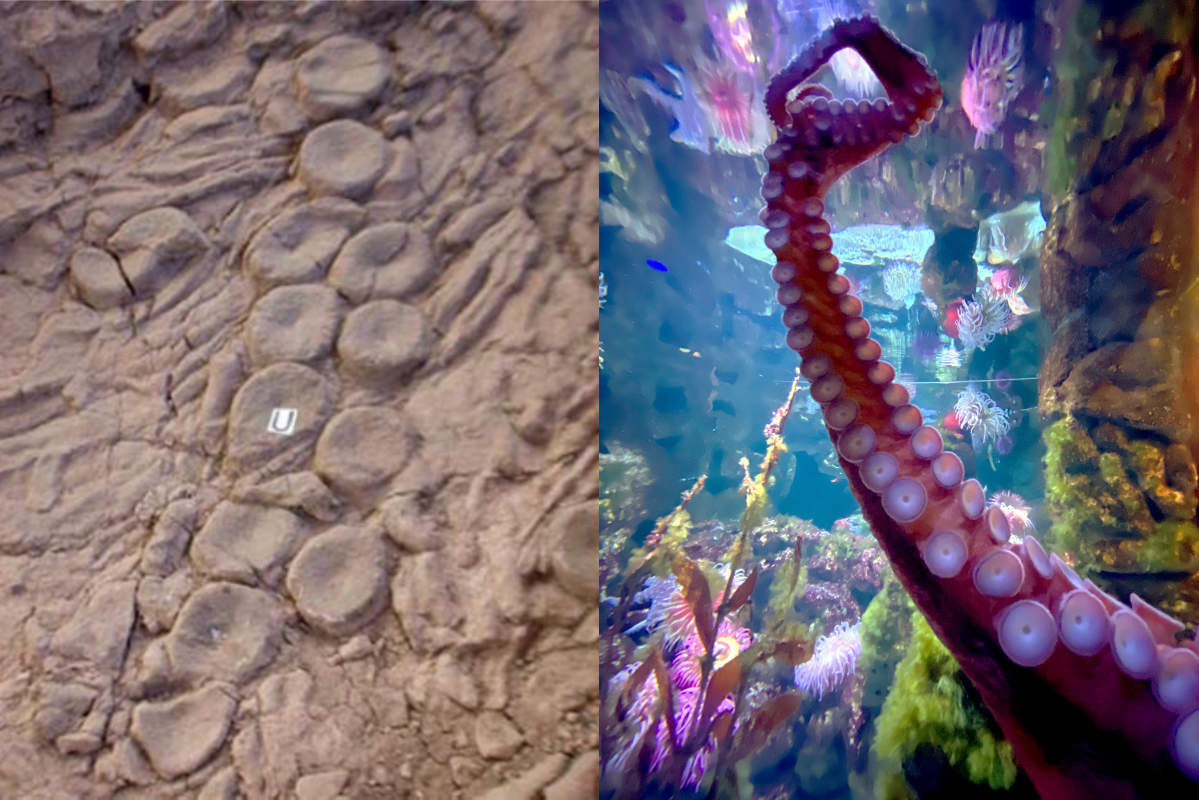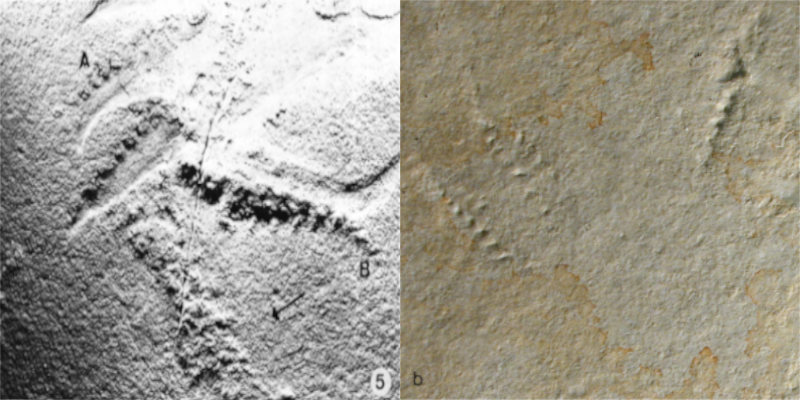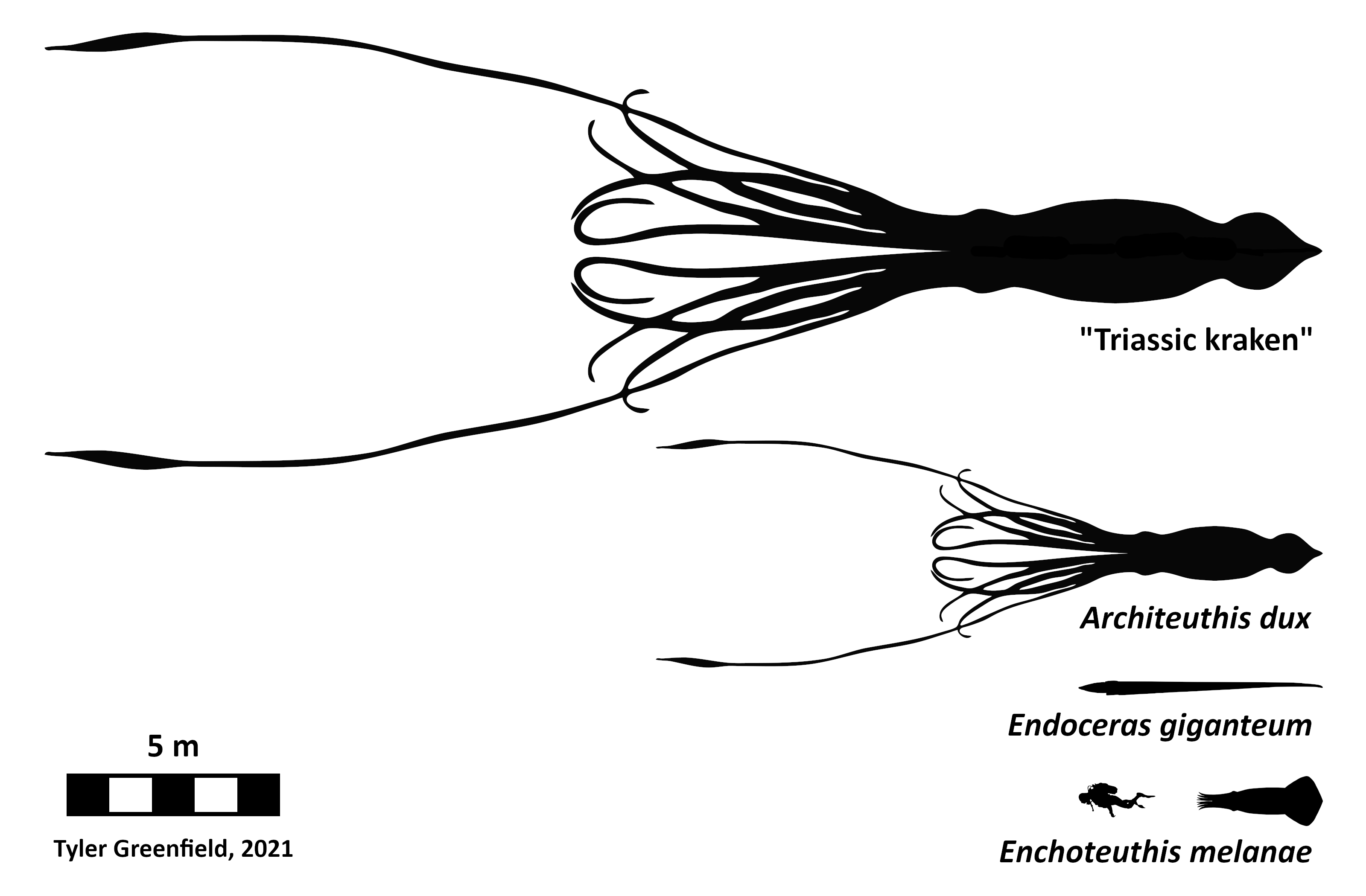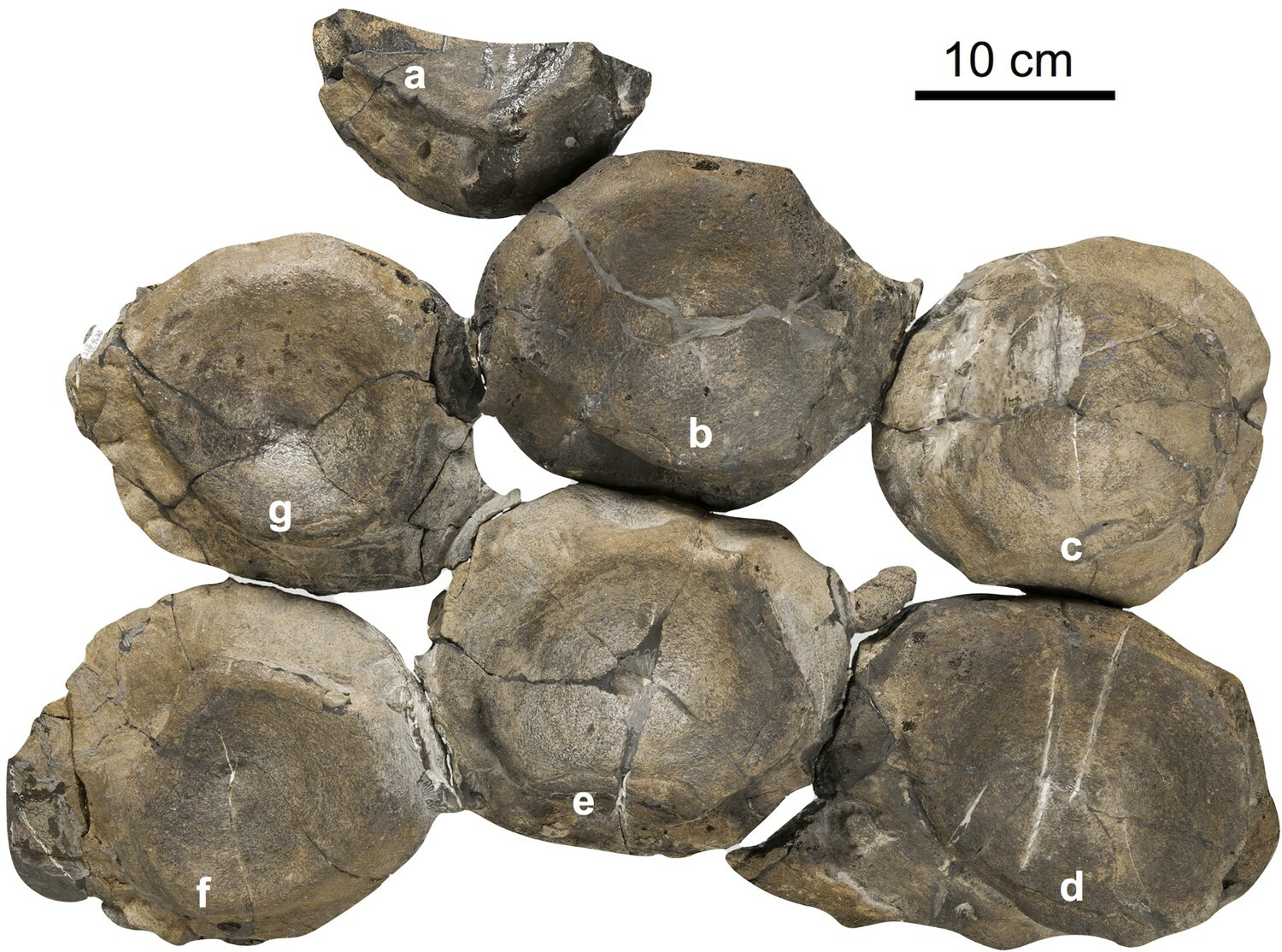
Shonisaurus vertebrae arranged in rows compared with the suckers of a modern octopus, from McMenamin (2012) and Wikimedia Commons (Betty Wills, CC BY-SA 4.0) respectively.
A decade ago, Mark McMenamin created one of the most notorious hypotheses in paleontology – the Triassic kraken. It was initially published as an abstract at a GSA meeting (McMenamin & Schulte McMenamin, 2011), which was followed by a magazine article (McMenamin, 2012), another GSA abstract (McMenamin & Schulte McMenamin, 2013), and a book chapter (McMenamin, 2016). McMenamin speculated that accumulations of the Late Triassic ichthyosaur Shonisaurus at Berlin-Ichthyosaur State Park in Nevada were caused by a giant, intelligent cephalopod. His main evidence was the arrangement of the Shonisaurus vertebrae in double rows, which he thought mimicked cephalopod suckers. According to him, the kraken had organized the vertebrae as a form of self-portrait.
The Triassic kraken was widely criticized by scientists online (Black, 2011; Myers, 2011; Prothero, 2011). They focused on taphonomic explanations for the vertebral orientation and the lack of any remains from the kraken itself. However, they did not point out how this hypothesis contradicts what is known about cephalopod evolution in the fossil record. McMenamin postulated that the kraken is a member of the subclass Coleoidea, which includes all cephalopods with internal shells. Coleoids are divided into two superorders, the 8-armed Octobrachia (octopuses, vampire squids, and relatives) and 10-armed Decabrachia (squids, cuttlefishes, and relatives). Coleoids have two types of sucker arrangements, uniserial (one row) and biserial (two rows), the latter of which was proposed for the kraken.

Preserved uniserial suckers in the belemnites Belemnotheutis antiquus (left) and Acanthoteuthis sp. (right), from Donovan & Crane (1992) and Fuchs et al. (2010) respectively.
There is a vital question that McMenamin entirely overlooked: did Late Triassic coleoids actually have biserial suckers? While he compared the arrangement of Shonisaurus vertebrae to modern coleoid suckers, he did not examine any fossil taxa. The only coleoids currently known from the Late Triassic are the orders Belemnitida and Phragmoteuthida, which are basal decabrachians (Iba et al., 2012; Fuchs & Donovan, 2018), and Prototeuthidina, which are basal octobrachians (Schweigert & Fuchs, 2012). The Jurassic belemnites Belemnotheutis and Acanthoteuthis have preserved uniserial suckers (Donovan & Crane, 1992; Fuchs et al., 2010), so Triassic species likely had them as well. Arms have not yet been found in phragmoteuthids, but given their close relationship to belemnites they probably also had uniserial suckers.

Preserved uniserial suckers in Plesioteuthis prisca, from Bandel & Leich (1986) and Donovan & Fuchs (2016) respectively.
In prototeuthids, the Jurassic Plesioteuthis, Rhomboteuthis and Romaniteuthis have preserved uniserial suckers (Bandel & Leich, 1986; Donovan & Fuchs, 2016). Thus, none of the coleoids that lived in the Late Triassic would have had biserial suckers. The presence of uniserial suckers in both basal decabrachians and basal octobrachians suggests that this condition was ancestral to Coleoidea. It also suggests that biserial suckers in extant decabrachians and octobrachians were evolved independently of each other. While it is not impossible that an unknown lineage of coleoids evolved biserial suckers in the Late Triassic, there is nothing to support this. The resemblance of the Shonisaurus vertebrae to suckers is completely coincidental, which eliminates the core evidence of McMenamin’s hypothesis.

A size comparison between the Triassic kraken and some of the largest cephalopods. The Endoceras and Enchoteuthis silhouettes are my own, while the Architeuthis/kraken silhouette is modified from Jereb & Roper (2010).
Additionally, McMenamin’s conjectural length of 30 meters for the kraken conflicts with both extinct and extant cephalopod sizes. The Triassic coleoids were all small (total length <1 m) and the first large ones did not appear until the Cretaceous. The Cretaceous Enchoteuthis is the longest extinct coleoid, yet the largest specimen only has an estimated total length of 2.96 m (see this post). The largest specimen of the longest extinct cephalopod, Endoceras, has an estimated shell length of 5.73 m (see this post). The longest extant coleoid (and cephalopod of all time) is the giant squid Architeuthis dux, the largest specimen of which has an estimated total length of 15.66 m (Romanov et al., 2018). All of these pale in comparison to the kraken, which would increase the maximum length of cephalopods by 92%. Simply put, this extreme size is highly implausible.
Given the lack of physical proof, the Triassic kraken belongs more in the realm of cryptozoology than paleontology. It has some parallels with (and may have been influenced by) the supergiant squids discussed by cryptozoologist Bernard Heuvelmans. Heuvelmans (1965/1968) suggested that there were squids up to 91 m long (!) living in the deep oceans. He connected them with the Norse legends of the kraken, which was also the namesake of McMenamin’s creation. His evidence was just as dubious, consisting of anecdotal reports of severed squid arms found in sperm whale stomachs and sucker marks on their skin. His methods of estimating length from these remains were flawed and, if the accounts were true, the squids would have been far smaller (McCormick, 2007).
It seems that the idea of giant cephalopods is alluring to fringe scientists, no matter how scant and questionable their evidence is. Unfortunately, the claims of McMenamin, Heuvelmans, and others promote gross misconceptions about cephalopod biology and evolution. Hopefully, this rebuttal to the Triassic kraken can lay some of those misconceptions to rest for good.
Addendum (4/28/2022)

Ichthyosaur vertebrae from Switzerland arranged in a double row, from Sander et al. (2022).
Sander et al. (2022) report a new occurrence of biserial arrangement in ichthyosaur vertebrae from the Late Triassic Kössen Formation of Switzerland. The ichthyosaur in question is a large shastasaurid fairly similar to Shonisaurus. This discovery shows that the taphonomic effect causing the arrangement was not unique to Berlin-Ichthyosaur State Park. Whether the effect was due to similar environments, similar sizes of the ichthyosaurs, or both, is uncertain.
Addendum (5/10/2023)

A drawing and photo of the holotype skeleton of Besanosaurus, from Dal Sasso & Pinna (1996) and Bindellini et al. (2021) respectively.
An additional example of biserial arrangement in ichthyosaur vertebrae is found in the tail of the Besanosaurus leptorhynchus holotype (Dal Sasso & Pinna, 1996; Bindellini et al., 2021). McMenamin has also published yet another paper advocating for the Triassic kraken (McMenamin, 2023). It does not address any of the criticisms that I have made, but it does present a revised length estimate of 28.6 meters based on scaling of a putative “beak”.
References
- Bandel, K., & Leich, H. (1986). Jurassic Vampyromorpha (dibranchiate cephalopods). Neues Jahrbuch für Geologie und Paläontologie, Monatshefte, 1986(3), 129-148.
- Bindellini, G., Wolniewicz, A.S., Miedema, F., Scheyer, T.M., & Dal Sasso, C. (2021). Cranial anatomy of Besanosaurus leptorhynchus Dal Sasso & Pinna, 1996 (Reptilia: Ichthyosauria) from the Middle Triassic Besano Formation of Monte San Giorgio, Italy/Switzerland: Taxonomic and palaeobiological implications. PeerJ, 9, Article e11179. https://doi.org/10.7717/peerj.11179
- Black, R. (2011, October 10). The giant, prehistoric squid that ate common sense. Wired. https://www.wired.com/2011/10/the-giant-prehistoric-squid-that-ate-common-sense/
- Dal Sasso, C., & Pinna, G. (1996). Besanosaurus leptorhynchus n. gen. n. sp., a new shastasaurid ichthyosaur from the Middle Triassic of Besano (Lombardy, N. Italy). Paleontologia Lombarda, Nuova serie, 4, 3-23.
- Donovan, D.T., & Crane, M.D. (1992). The type material of the Jurassic cephalopod Belemnotheutis. Palaeontology, 35(2), 273-296.
- Donovan, D.T., & Fuchs, D. (2016). Part M, chapter 13: fossilized soft tissues in Coleoidea. Treatise Online, 73, 1-30.
- Fuchs, D., von Boletzky, S., & Tischlinger, H. (2010). New evidence of functional suckers in belemnoid coleoids (Cephalopoda) weakens support for the ‘Neocoleoidea’ concept. Journal of Molluscan Studies, 76(4), 404-406.
- Fuchs, D., & Donovan, D.T. (2018). Part M, chapter 23C: systematic descriptions: Phragmoteuthida. Treatise Online, 111, 1-7.
- Heuvelmans, B. (1968). In the wake of the sea-serpents (R. Garnett, Trans.). Hill and Wang. (Original work published 1965).
- Iba, Y., Sano, S., Mutterlose, J., & Kondo, Y. (2012). Belemnites originated in the Triassic – a new look at an old group. Geology, 40(10), 911-914.
- Jereb, P., & Roper, C.F.E. (2010). Cephalopods of the world. An annotated and illustrated catalogue of cephalopod species known to date. Volume 2. Myopsid and oegopsid squids. FAO Species Catalogue for Fishery Purposes, 4(2), 1-605.
- McCormick, C. (2007, March 11). Ludicrous giant squid claims. The Lord Geekington. http://cameronmccormick.blogspot.com/2007/03/ludicrous-giant-squid-claims.html
- McMenamin, M.A.S. (2012). Evidence for a Triassic kraken: unusual arrangement of bones at Ichthyosaur State Park in Nevada. 21st Century Science & Technology, 24(4), 55-58.
- McMenamin, M.A.S. (2016). Dynamic paleontology: Using quantification and other tools to decipher the history of life. Springer.
- McMenamin, M.A.S. (2023). A Late Triassic nuculanoid clam (Bivalvia: Nuculanoidea) and associated mollusks: Implications for Luning Formation (Nevada, USA) paleobathymetry. Geosciences, 13(3), Article 80. https://doi.org/10.3390/geosciences13030080
- McMenamin, M.A.S., & Schulte McMenamin, D.L. (2011). Triassic kraken: the Berlin ichthyosaur death assemblage interpreted as a giant cephalopod midden. Geological Society of America Abstracts with Programs, 43(5), 310.
- McMenamin, M.A.S., & Schulte McMenamin, D.L. (2013). The kraken’s back: new evidence regarding possible cephalopod arrangement of ichthyosaur skeletons. Geological Society of America Abstracts with Programs, 45(7), 900.
- Myers, P.Z. (2011, October 10). Traces of a Triassic kraken? Pharyngula. https://web.archive.org/web/20111013043139/https://scienceblogs.com/pharyngula/2011/10/traces_of_a_triassic_kraken.php
- Prothero, D. (2011, November 2). Octopus’ garden in the shale? Skepticblog. https://www.skepticblog.org/2011/11/02/kraken-and-crackpots/
- Romanov, E.V., Jaquemet, S., & Puetz, L. (2018). A giant squid (Architeuthis dux) off Reunion Island, western Indian Ocean: the greatest giant ever? Journal of the Marine Biological Association of the United Kingdom, 98(8), 2087-2093.
- Sander, P.M., de Villar, P.R.P., Furrer, H., & Wintrich, T. (2022). Giant Late Triassic ichthyosaurs from the Kössen Formation of the Swiss Alps and their paleobiological implications. Journal of Vertebrate Paleontology, Article e2046017. https://doi.org/10.1080/02724634.2021.2046017
- Schweigert, G., & Fuchs, D. (2012). First record of a true coleoid cephalopod from the Germanic Triassic (Ladinian). Neues Jahrbuch für Geologie und Paläontologie, Abhandlungen, 266(1), 19-30.

Excellent job as always. My only criticism is calling the basal octobrachians “Prototeuthidina” in one paragraph then “plesioteuthids” in the next. Not sure if one is a subgroup of the other, etc. but consistency would help readability.
LikeLiked by 1 person
Good catch, I meant to write “prototeuthids” so I will change it. Plesioteuthids are a family of prototeuthids.
LikeLike
Yeah, the whole “Triassic Kraken” thing is ludicrous no matter what angle you look at it from. I agree that it belongs alongside Bigfoot and the Chupacabra: strictly in the realms of pseudoscience and cryptozoology.
I’ll also add that, even if there WAS a giant KrAkEn (using the name “Kraken” unironically should be the first indicator of pseudoscience imo) hanging out alongside marine reptiles of the time, that doesn’t automatically make it an Ichthyosaur-killing supermegaultraprimemechadeath predator. I mean, most of the giant and colossal squids’ known prey items (primarily small fish and other cephalopods) aren’t even half their size.
LikeLiked by 1 person